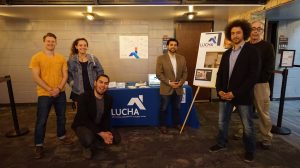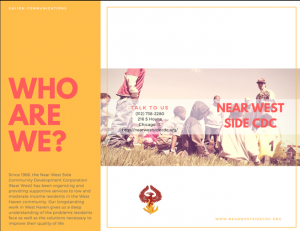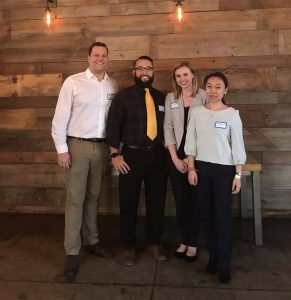Brief description of the project
We held a ticketed benefit concert featuring Chicago artist, Michelle J. Rodriguez, at Stage 773, a small theatre venue in Chicago to raise both money and awareness for LUCHA. Michelle is a Latina artist who has a band, MICHA, which plays a mix wide range of original music (including jazz, Latin, R&B) and she has played several similar types of events in Chicago. We promoted the event via social media, the venue, and LUCHA. At the event we had a few people from LUCHA speak about the organization and we had a table with promotional materials including ways to get involved with the organization. We also set up a GoFundMe page in order to raise additional money (and awareness) for LUCHA, as well as a 50/50 raffle at the event that helped us raise more money.
Brief description of the charity
LUCHA, founded in 1982, is the Latin United Community Housing Association. They are a non-profit organization that advances housing as a human right by empowering communities – particularly the Latino and Spanish-speaking populations- through advocacy, education, affordable housing development and comprehensive housing services. Their main goals are to combat displacement and to preserve affordable housing in the community. LUCHA has helped more than 68,000 low-to-moderate income families with tasks such as rental assistance, rent and finding affordable housing, emergency repairs, and many others.
Factual analysis of success in terms of project objectives
Social Media Engagement:

Financials:
| Revenue |
Expenses |
| GoFundMe – $610 |
Venue – $300 |
| 50/50 Raffle – $180 |
Raffle Tickets – $10 |
| Ticket Sales – $240 |
Artist (MICHA) – $200 |
| Total Revenue |
Total Expenses |
| $1,030 |
$510 |
In total, we generated revenue of $1,030 and had expenses of $510. Thus, were able to generate $520 in profit!
Attendance: Our original goal for attendees was around 45 people. However, we fell short of our goal as we only had seven outside participants. This may have been due in part to our show being on a Monday or a lack of marketing from our stakeholders, but even with the low attendance we were still able to raise awareness and money.
Two or three lessons learned about managing projects
Be extremely thorough in your communication process. There are many stakeholders involved in these type of projects, so it’s very important to be as explicit as possible to ensure that everyone is on the same page and knows what’s going on. Selecting the appropriate communication channels for each stakeholder ought to be carefully considered based on varying schedules, preferred styles of communicated, and timeliness of response required.
Stay organized and prepared by creating WBS’s and Risk Management Plans. These will ensure that your group is ready to take on whatever tasks needed to complete the project, but will also make sure that your group is prepared for unforeseen circumstances that can affect the status of the project. Assigning accountability through these project management tools helps the project stay on track as well as ensure everyone is working together to complete various deliverables according to schedule.
Lastly, it’s important to understand that even with a risk management plan in place, it’s important for all group members to be flexible. This means that each group member is willingly able to adapt to any given situation that may arise and could change the logistics of the event. Communication is again a factor here, as well as a generalized positive and optimistic attitude to carry out unforeseen changes to plans to help the event run as smoothly as possible.
Advice for future teams doing similar projects
Our advice for future teams doing similar projects largely revolves around ensuring they are fully aware and adequately prepared to coordinate the large scope of responsibilities for a benefit concert or event of a similar scale. This event was far more challenging than initially anticipated given the variety of stakeholders as well as the short timeline we were operating under. Therefore, effective communication was key throughout our planning process. We want to highlight the importance of the “ABC Rule” (Always Be Communicating) with the team as well as updating external stakeholders on a regular basis. We found it very helpful to always be communicating whether it was through email correspondence or weekly meetings with our group.
Additionally, securing a venue for a concert on a short timeline with limited budget turned out to be more difficult than we originally anticipated. We therefore suggest doing this sooner rather than later in order to ensure you find the best venue, on the date you want and for a reasonable price. Remember, there will be communication barriers with the venue’s and they won’t always get back to you in a timely manner (if they even get back to you at all). Also, when it comes to the money to rent out a venue, thinking through payment is critical. In most cases, the group must put down a deposit up front to secure the venue spot, which creates a risk of losing money should the event turnout fail to generate enough attendance to cover these up-front costs. These are factors that need to be addressed in a project similar to this.
Also, we encountered some unforeseen challenges we ran into were permissions and coordinating the exchange of funds. If you’re planning on doing some sort of online fundraising (GoFundMe for example) make sure you know all the logistics about the process of getting the money in and out of the fundraising account. Due to the fact that we signed up as a “Charity” account instead of “Personal”, it made our process of withdrawing the money much more difficult and we needed assistance from LUCHA and PayPal.
Lastly, we would advise teams doing similar projects to have an effective marketing channel strategy. Despite low attendance at our event, we were able to raise awareness, which was our primary objective. We were able to do this through an effective marketing channel by using social media, local marketing and effective relationship marketing. All of these elements helped us raise awareness for our organization and allowed us to meet our main objective.
Photos related to the project





































